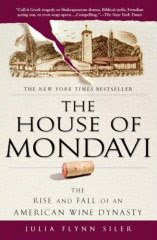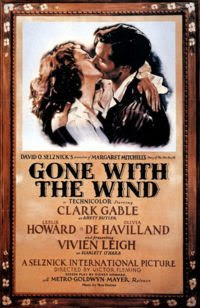My guest blogger this Wednesday is Julia Flynn Siler, whose bestselling House of Mondavi is a finalist for the James Beard Foundation Award and for a Gerald Loeb Award. Like Margaret Mitchell, whom she writes about here, Julie is a “Girl Reporter Turned Bestselling Author.” For both, years of work underlie the “overnight” success.
 One of the most uplifting stories I’ve come across recently is that of Margaret Mitchell, author of Gone with the Wind. Known as Peggy by her friends, Mitchell became the first woman to cover hard news in the early 1920s for the Atlanta Journal, one of the predecessor papers to today’s Atlanta Journal Constitution.
One of the most uplifting stories I’ve come across recently is that of Margaret Mitchell, author of Gone with the Wind. Known as Peggy by her friends, Mitchell became the first woman to cover hard news in the early 1920s for the Atlanta Journal, one of the predecessor papers to today’s Atlanta Journal Constitution.
A fifth-generation Atlantan from a socially prominent family, Mitchell stood just four feet ten inches and shocked Atlanta society during her debut by staging a racy “Apache Dance.” She’s denied admission to the Junior League in part because of that dance, but also because she did charity work in the wards of a local hospital with African Americans.
A fall from a horse, as well as ongoing pain in her ankles and feet, landed Mitchell in bed in 1926, forcing her to quit her job as a reporter. Her husband John Marsh, also a former reporter, brought her books from the library. But one day, as she lay in bed in the couple’s cramped one-bedroom apartment that Mitchell had nicknamed “The Dump,” John brought her something else instead.
“Madam, I greet you on the beginning of a new career,” he said, plunking a Remington typewriter down in front of her. Mitchell started writing – stashing chapters or portions of chapters all over the house, tucked into manila folders. Three years later, in 1929, she completes the bulk of her book.
It languished in the proverbial drawer (or, more precisely in Michell’s case, those manila folders) for six years, until Harold Latham of McMillan Publishing, on a scouting expedition for new literary talent to Atlanta, reads it and is mesmerized. His only major change was to rename Mitchell’s heroine Scarlett instead of Pansy, which was what the fiery tempered beauty of Mitchell’s book was originally called.
Until J.K. Rowling came around, Mitchell’s publishing house could boast that her book sold more copies worldwide than any other book except the Bible. Mitchell was awarded a Pulitzer Prize for her novel in 1937 and it became a Hollywood movie starring Vivien Leigh as Scarlett and Clark Gable as Rhett Butler.
Hollywood movie starring Vivien Leigh as Scarlett and Clark Gable as Rhett Butler.
Although my experience isn’t as dramatic as Mitchell’s, there are some parallels. I, also, have been “a girl reporter” for most of my working life – writing for the Wall Street Journal, BusinessWeek, and the New York Times. After a stint as a London-based foreign correspondent for BusinessWeek and then the Journal, I returned to the U.S. and had a brief and unhappy experience working in a family business.
The business broke up and I returned to writing for the Journal. In one of those quirks of fate, ended up writing a front-page story for the paper about the Mondavi family and the Napa Valley-based wine empire they had founded. A day or two after the story ran, a publisher in New York named Bill Shinker at Gotham Books emailed me, asking if I would consider writing a book about the family based on my story.
In one sense, it was my Cinderella moment. But my reaction – instead of joy – was one of dread. None of the principal actors in the unfolding family drama at the Robert Mondavi Corporation had agreed to talk to me for my Journal story. How could I write a book without their help?
Three years and more than 500 hours of interviews later – including with most of the key family members – The House of Mondavi was published. Almost immediately, it hit the New York Times bestseller list. The hardcover edition is now in its eighth printing and the paperback just came out May 1st. I’m very honored to say it’s also a finalist for a James Beard Foundation Award and for a Gerald Loeb Award for distinguished business reporting.
I hadn’t known much about Margaret Mitchell before my book event in Atlanta this week for the paperback tour of The House of Mondavi, I had the great pleasure of visiting the Margaret Mitchell House & Museum with my 80-year-old escort Mendel Romm, who drove me there in his wife’s midnight blue Cadillac STS. Mendel, a born and bred Atlantan, had met Margaret Mitchell, as well as Martin Luther King, Jr., and most ever other prominent Atlantans. When we got to the Margaret Mitchell House, Sarah Dollacker took Mendel and me us on a guided tour.
Sarah is a book blogger, who maintains a delightful site called Red Room Library in her spare time. She helped explain that the Margaret Mitchell House has become a literary hub for Atlanta, hosting authors several times a month and providing a home for book clubs, as well as helping to organize the annual Georgia Author Book Bash, held this year on June 29th.
Mitchell died in 1949, before turning fifty. She was hit by a car driven by an off-duty cab driver as she was crossing Peachtree Street to go to the theater. I can’t help but think she would be tickled to be hosting literary soirees for other journalists-turned-authors such as Tony Horwitz, who spoke there to rave reviews on Wednesday night about his new book, A Voyage Long and Strange.
Horwitz and Mitchell may have lived a half a century apart from one another. But they both found a way to channel their journalistic skills into other, arguably even more powerful forms of storytelling. As Peggy’s novelistic creation Scarlett O’Hara – the ultimate survivor — might say to all those discouraged journalists out there trying to figure out what to do next: “Tomorrow is another day!”
–Julia Flynn Siler